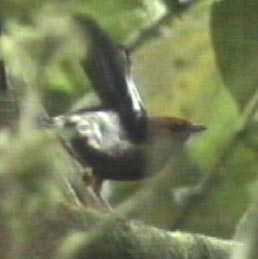
A male club-winged manakin - Courtesy of Kimberly BostwickHummingbirds and rattlesnakes move parts of their bodies at amazing speeds. But male club-winged manakins -- colorful, sparrow-sized South American birds -- have them both beat, vibrating their wings at more than 100 cycles per second, twice the speed of hummingbirds. The bird uses this unprecedented feat not for fight or flight, but to impress females with its violinlike hum.
Similar to how a cricket chirps by rubbing together sound-making apparatus in its wings, male club-winged manakins (Machaeropterus deliciosus) use specially adapted feathers in each wing to make a tone, according to a Cornell University ornithologist in the July 29 issue of Science. The sound and how the bird produces it are unique among vertebrates.
"Essentially an instrument has evolved in this species, in this case a refined instrument," said Kimberly Bostwick, the paper's lead author, a curator in the birds and mammals division of Cornell's Museum of Vertebrates and a research associate in the Department of Ecology and Evolutionary Biology.
The club-winged manakin, found only in a strip of threatened cloud forest on the western slopes of the Andes Mountains along the extreme northwest corner of Ecuador extending into Colombia, has adapted its wings in this odd way due to sexual selection -- the sound makes the male more attractive to females of the species.
"In general, if an adaptation is really weird and out there, it is produced by sexual selection," said Bostwick, pointing out that peacock wings are another example of an adaptation due to sexual selection.
Darwin mentions the club-winged manakin in "The Descent of Man," his treatise on sexual selection and how characteristics that attract the opposite sex are passed down to the next generation. Darwin was fascinated that birds have vocal chords and sing, but he was particularly struck that some birds make noise with their bodies, Bostwick said. Although Darwin's book includes illustrations of the club-winged manakin's unusual feathers, Darwin did not know about the sound they produce or how it is generated. Since the bird makes the noise by moving its wings at a blinding speed, that finding had to wait for technology that has only been developed in the last few years, said Bostwick, noting that this study marks the first explanation of how these birds generate the tone.
When Bostwick first went to the Andes in 1997 to study the birds, she realized that conventional video cameras were too slow to capture how these birds make their sound. When she stumbled upon a digital video camera designed to capture up to 1,000 frames a second for high-speed industrial processes, she knew it would be invaluable for her 2002 visit. The camera also could record in the low-light environment of the cloud forest, was rugged, no bigger than a large pair of binoculars and came with a portable battery pack.
High-speed video recordings, played back in slow motion, revealed that to attract a mate, the male leans forward, raises its wings behind its back and flips them to make the hum. In humans, the move would be analogous to leaning forward and touching elbows and pinkies behind one's back.
After careful analysis, Bostwick determined that special inner (or secondary) feathers rub together to make the sound. Each wing has one feather with a pick, or a small blade, and an adjacent feather with ridges and enlarged and hollow shafts. While perched, the bird hits the wings together at a very high speed. Each wing creates its own violinlike hum as the pick feather rubs against the adjacent ridged feather.
Manakins are lek-breeding birds, meaning that the males compete to mate, while the females raise the young. Since the males do not couple to raise young, a single male could inseminate all the local females. Therefore, competition for females among lek-breeding birds creates strong pressures for sexual selection.
While other birds make wing sounds -- including other types of manakins, grouse, pheasants, hummingbirds and birds of paradise -- and many of the 40 kinds of manakins have developed wing buzzes, snaps and hums, none of these sexually selected adaptations are as extreme as the club-winged manakin, Bostwick said.
Source : Cornell University News Service
 Print Article
Print Article Mail to a Friend
Mail to a Friend
